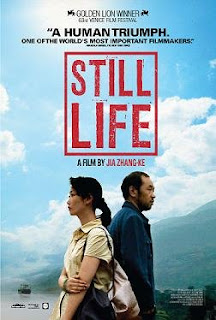Still Life

Jia Zhang-Ke's Still Life is a quietly powerful film of lost love set against the backdrop of the construction of the Three Gorges Dam, and as such, it has the effect of an elegy. The dam required the relocation of over a million people and flooded towns that were 2,000 years old. Zhang-Ke asks us to focus on just two stories that play out while buildings are being demolished.
In one story, a man from the north of China comes to the town of Fengjie to find his wife and daughter, who left sixteen years before. He gets a rude awakening, when the only address he had for them is now under water. He stays on and gets a job on a demolition crew, waiting for his wife to return on a barge she works on.
Meanwhile, a young woman comes to town to find her wayward husband. She gets help from her husband's friend to find him, but he proves to be elusive. When she does find him she can only say that she wants a divorce.
Not a lot happens in Still Life, and the pace is leisurely, to put it kindly, but I thought it was interesting. As the city around them is marked for destruction and flooding, these people seem resigned to allow their lives to slip away from them. There's also a lot unspoken. When the man finally finds his wife, they have a quite but nonetheless gripping exchange. She finally asks him why he waited sixteen years to come find her. He has no answer, and that speaks volumes.
Zhang-Ke also inserts a few scenes of whimsy into his otherwise realistic film. At one point what looks like a flying saucer zooms by, and another more obvious reference to science fiction a large, unfinished concrete structure blasts off like a rocketship (Zhang-Ke, in an interview on the DVD, points out that cities that have been evacuated for destruction resemble those that have undergone alien attacks in sci-fi films), and the last scene of the film shows a wirewalker balancing over the rubble of the city.


Comments
Post a Comment